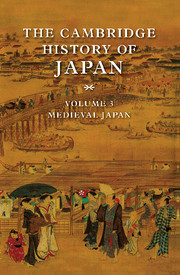Book contents
- Frontmatter
- Introduction
- 1 The Kamakura bakufu
- 2 Medieval shōen
- 3 The decline of the Kamakura bakufu
- 4 The Muromachi bakufu
- 5 Muromachi local government: shugo and kokujin
- 6 The decline of the shōen system
- 7 The medieval peasant
- 8 The growth of commerce in medieval Japan
- 9 Japan and East Asia
- 10 CULTURAL LIFE IN MEDIEVAL JAPAN
- 11 The other side of culture in medieval Japan
- 12 Buddhism in the Kamakura period
- 13 Zen and the gozan
- Works cited
- Glossary
- Index
- References
3 - The decline of the Kamakura bakufu
Published online by Cambridge University Press: 28 March 2008
- Frontmatter
- Introduction
- 1 The Kamakura bakufu
- 2 Medieval shōen
- 3 The decline of the Kamakura bakufu
- 4 The Muromachi bakufu
- 5 Muromachi local government: shugo and kokujin
- 6 The decline of the shōen system
- 7 The medieval peasant
- 8 The growth of commerce in medieval Japan
- 9 Japan and East Asia
- 10 CULTURAL LIFE IN MEDIEVAL JAPAN
- 11 The other side of culture in medieval Japan
- 12 Buddhism in the Kamakura period
- 13 Zen and the gozan
- Works cited
- Glossary
- Index
- References
Summary
INTRODUCTION
The 1260s marked the beginning of a decisively new period for the Kamakura bakufu as it faced a set of increasingly complex problems caused by changing conditions both at home and abroad. The political structure of the bakufu was about to undergo a major change the death of Hōjō Tokiyori in 1263, which in effect ended the “Golden Period” characterized by the regency (shikken) system. At the same time, changes in the social, economic, and technological spheres were beginning to shake the shoōn system, which had been flourishing since the eleventh century. As examples of these changes, improved agricultural technology increased arable acreage, and the technique of double cropping – planting wheat after harvesting the rice – also enhanced productivity. The greater surplus in turn led to the diversification of agriculture, and as witnessed by the opening of periodic markets, commerce and trade likewise became more important. Simultaneously, peasants with free time or surplus means produced various handicrafts to be sold at market. A cash economy made advances as a large quantity of coins was imported from China, giving rise to financial middlemen and the practice of paying shōen taxes in cash.
These changes could not have taken place without influencing the overall social fabric. In various regions, cultivators rose up against the local jitō or shōen proprietors. In the meantime, the jitō and proprietors themselves began to compete, the worst of such confrontations occurring in the home provinces and the west, often involving military forces.
- Type
- Chapter
- Information
- The Cambridge History of Japan , pp. 128 - 174Publisher: Cambridge University PressPrint publication year: 1990
References
- 5
- Cited by

